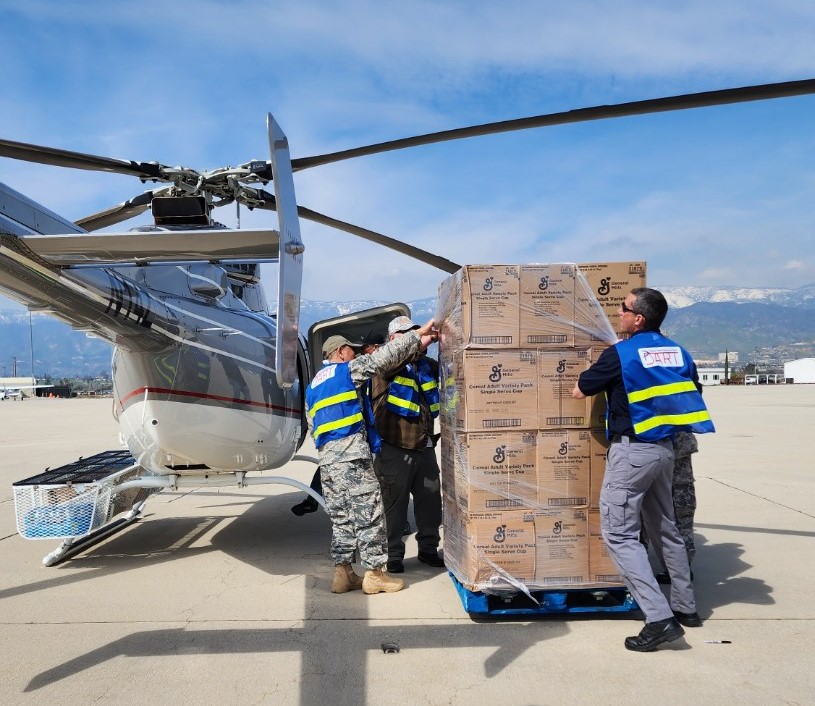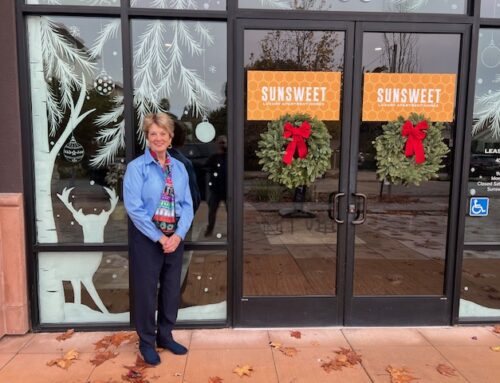Organization mobilizes private pilots to move people and supplies during emergencies
![]()

CalDART and Civil Air Patrol volunteers load a CalDART helicopter with food to take up the mountain. Photo courtesy CalDART
By Calvin Nuttall
 When disaster strikes, the pilots of South Valley are ready to answer the call to action.
When disaster strikes, the pilots of South Valley are ready to answer the call to action.
Beneath the banner of the California Disaster Airlift Response Team, local pilots, radio operators, and other aviation specialists gathered at San Martin Airport to conduct exercises May 3. They aimed at preparing the group of volunteers to mobilize in the event of disaster.
Paul Marshall is the president and director of CalDART, a public-benefit corporation. The organization has taken different forms during the years, but Marshall has been at its forefront since its beginning in 2008.
“The idea of the network is we have people around the state, with their own DARTs in their own communities, and when anybody has a problem, we can all go in and help,” he explained. “We’ve got people experienced at ground operations, and pilots who are experienced at flying. If they have a pilot’s license and are current with their operations, we can use them.”
The local chapter of CalDART collaborated with the South County Airport Pilots Association to organize their annual exercises at the San Martin Airport. SCAPA is the local chapter of the California Pilots Association.
“We have slightly more than 400 pilots registered with us in the state,” Marshall said. “Here at San Martin we have something like 10 that are on the steering committee, and then the whole SCAPA membership of about 85 pilots. You know, pilots love to fly to help when there is a disaster, and we exist to be able to organize it all.”
On the day of the exercises, the weather was tempestuous, but the volunteers of CalDART gathered in their hangar to await acceptable conditions for takeoff. The hangar space, donated to the organization by Santa Clara County, was crammed with radio equipment and eager volunteers ready to simulate a mock airlift operation as soon as the weather cleared.
“We have the pilots assembled, we have the people assembled, and when the weather lifts, we go,” Marshall said. “When disasters happen, you don’t know what it is going to be out there. You have to be ready for anything.”
While the pilots and passengers waited, the on-the-ground teams simulated their portion of the operation. They have a customer service department for conducting outreach to the community and find out what their needs are. A flight operations group assigns individual pilots to the needs that are identified.
“We do the annual exercises because you’ve gotta maintain your local relations with your emergency managers,” he said. “We do this sort of thing to keep our skills sharp. Every year we have new people involved, and there is turnover. We want to get everybody trained on how we do it, and what the safety factors are, because you never know who is going to be available at the onset of a disaster.”
There are roughly 50,000 pilots in California with about 26,000 planes, Marshall said. This gives the grassroots organization the potential to scale up in the event of a major regional disaster.
“It gets more difficult to organize the bigger the operation gets, and that’s why we do these exercises,” he said. “Disasters are hard to serve. If you talk to any emergency management professional, they’ll tell you that it gets so complicated, and tempers flare. We have agency territory disputes. But mostly, it’s just how we take all of those resources and coordinate them into a safe and effective effort.”
The organization is called upon to conduct major operations roughly once a year. Their most recent mobilization was a response to a series of snow storms in the San Bernardino mountains, which caused a large number of residents to be stuck in their homes in February 2023.
“No food was getting in,” Marshall explained. “They didn’t have any idea of when the roads would reopen. The neighborhoods and highways were not plowed. The CHP was stopping all traffic at the bottom of the mountain.”
Meanwhile, people were stranded in their homes who needed urgent access to medical supplies. Patients who need frequent procedures such as dialysis and intravenous fluid injections could die if cut off from supplies for too long.
“So, we did a helicopter airlift,” Marshall said. “We got our first helicopter there the next day. We started out using the helipad at the San Bernardino Community Hospital, which was the base lower-elevation helipad, and then we used Mountain Community Hospital’s helipad up on the hill. We started moving medical supplies.”
In concert with other local organizations in the area, including the Community Emergency Response Team and Team Rubicon, CalDART airlifted 20,000 pounds of food and medical supplies in 31 flights. Even simple things, like groceries, were airlifted. People couldn’t even drive their cars to go to the store, so teams on the ground coordinated to distribute food from door to door, while helping people dig themselves out of their homes.
“As pilots, we do a lot of training,” Marshall said. “You put a lot of investment into being able to be a competent pilot, and to have a plane that is airworthy. It is nice to be able to apply yourself to something. These helicopter pilots that did the San Bernardino Mountains airlift, a couple of them said to me that this was the most meaningful flying they’ve ever done in their lives. Everybody likes the feeling of giving back, and this is a wonderful opportunity.”
The San Martin Airport exercises ended as, mostly, a dry run. Only one flight was launched as a part of the operation, with most of the pilots choosing not to risk flying in the inclement weather. Nevertheless, Marshall noted, the operation was worthwhile because the pilots were organized and ready to fly at a moment’s notice.
“There was quite a discussion of, would we have an exercise today while the weather is terrible?” he said. “Well, when you think about it, that’s the best time to have an exercise. Because the weather is terrible, and because you will deal with a lot more issues than you would on a sunny day. Despite the fact that it wasn’t a great day to fly, we had a full slew of people out here volunteering and helping out and keeping all of the different systems running.”
Calvin Nuttall is a Morgan Hill-based freelance reporter and columnist.






